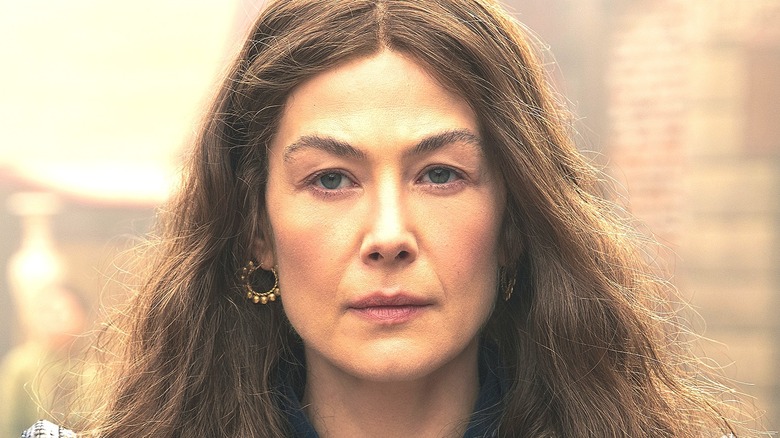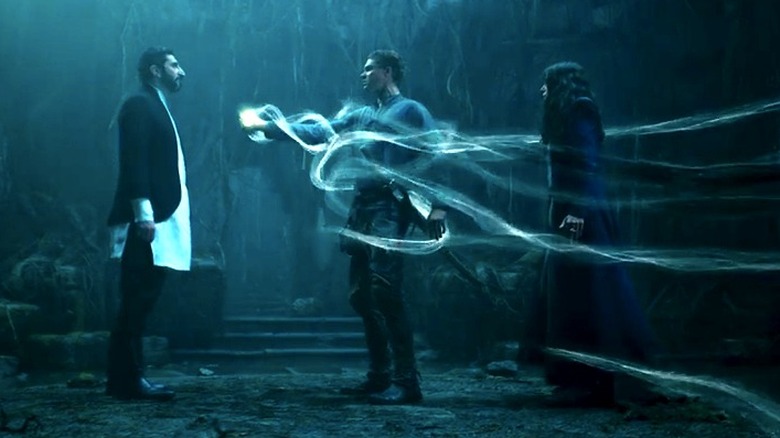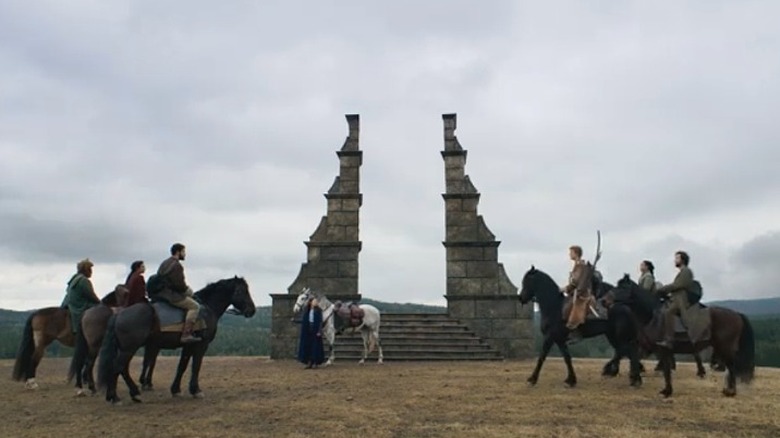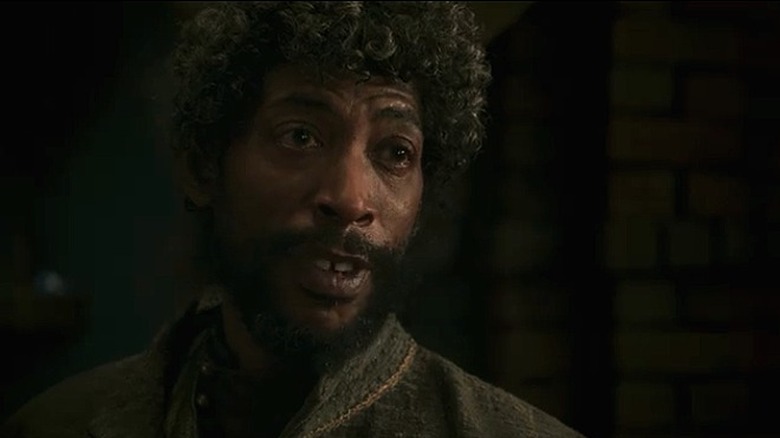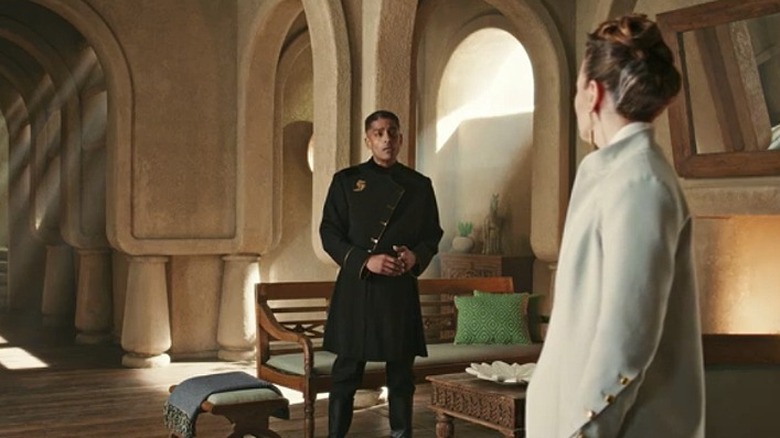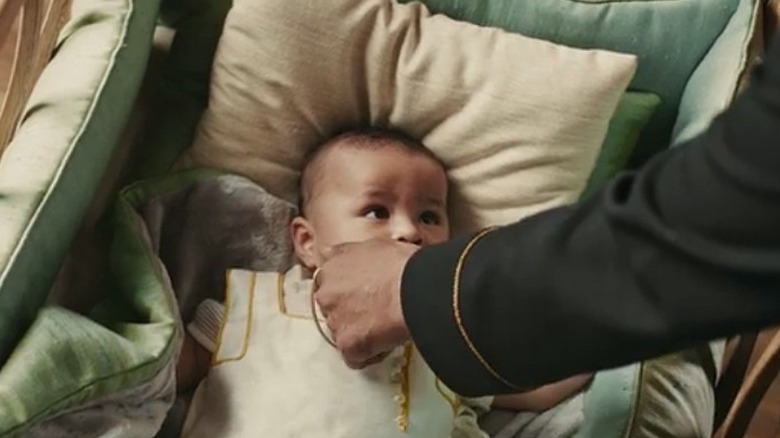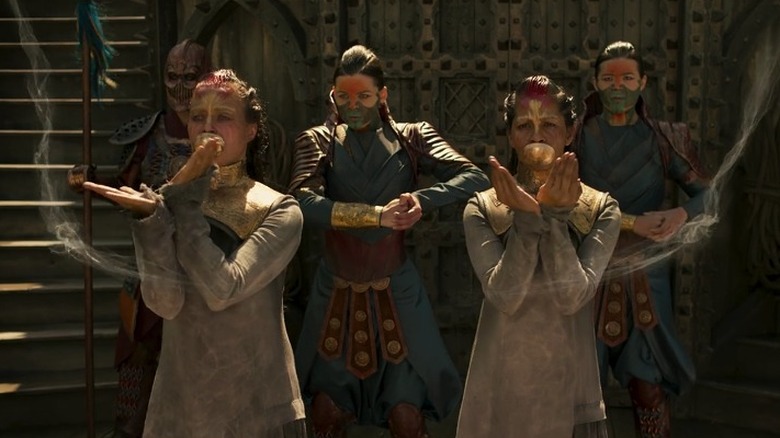The Ending Of The Wheel Of Time Season 1 Explained
Amazon's adaptation of Robert Jordan and co-writer Brandon Sanderson's epic fantasy series, "The Wheel of Time," concluded its inaugural season on December 24th, simultaneously revealing some of its most important themes while leaving audiences with almost as many questions as answers. Originally posited as Amazon's answer to HBO's "Game of Thrones," news of the Season 2 confirmation hit future fans everywhere months before its Season 1 premiere. However, to liken "The Wheel of Time" to "Game of Thrones" does a disservice to each. Aside from sharing a genre (fantasy) concerned with investigations into, and reflections of, the human condition, the forces of good and evil, the cost of the ongoing fight to secure (or justify) one or the other, and ordinary characters forced into extraordinary situations, the two series have very little else in common.
In its series finale, "The Wheel of Time" brought its distinct motivations and subtexts into stunning relief, and — despite criticism from its built-in fan base and a few unenthusiastic early reviews of the first six episodes — managed to pull its plot and pieces together in time to leave audiences intrigued for where Season 2 may take it. In order to understand all that's at stake for the series' multiple protagonists, it's worth taking a closer look at all the many revelations, nods, and intricate connections delivered in the series' finale episode.
The Wheel of Time wrestles with timeless themes in its Season 1 finale
The finale sees the characters battle the same demons with which art has concerned itself for millennia. After realizing that he's the Dragon Reborn, Rand (Josha Stradowski) sets out with Aes Sedai Moiraine (Rosamund Pike) to meet the Dark One face-to-face at the Eye of the World. Just as demons have done to mortals for centuries across a variety of cultures' defining mythologies, the Dark One appears to Rand in the form of a man who can offer him everything he desires. In order to defeat this particular demon, Rand must resist temptation by putting the needs and desires of those he loves before his own needs and desires. It's a timeless lesson in temptation, sacrifice, and the inherent darkness alive and well and waiting to be tapped in the souls and motivations of every human.
Despite struggling to understand his beloved Egwene's (Madeleine Madden's) needs throughout the beginning of the series, Rand ultimately proves himself worthy of both her love and the One Power by being able to resist creating the world over in "his image," because he knows his image isn't what Egwene wants. It's a sacrifice the Dark One is convinced he'll be unwilling to make, but Rand proves him wrong. Zoë Robins' Nynaeve also makes the ultimate sacrifice when she throws her body on Egwene in order to protect her from the strength of the One Power. Again and again, "The Wheel of Time" suggests that the Light may require a greater sacrifice, but the Dark exacts a much higher price, and only the truly powerful have the foresight and strength to understand (and subsequently resist) the call of the latter.
Episode 8 reveals the importance of all 5 Ta'veren
We've known from the onset of the series that Egwene, Rand, Nynaeve, Perrin (Marcus Rutherford), and Mat (Barney Harris), share a deep and important connection. In episode 7, the seer Min Farshaw (Kae Alexander) confirmed the quintet's inextricable link to one another when she explained that she could see "sparks of light trying to fill the shadows" in between them. Though various episodes have hinted at a possible five-headed reincarnation of The Dragon Reborn, this has yet to be fully confirmed by anything in the first eight episodes. (If anything, it's been disproven, since Rand himself appears to be the Dragon, just as he is in the novels). We do learn, however, that the five characters are linked in a very particular way.
When Padan Fain (Johann Myers) reveals his true character and motivations to Perrin, he explains that all five characters are "focal points for the wheel," and that while "Rand may be the Dragon," each of them has "a part to play" in the inevitable and ongoing battle between Light and Dark. It hardly seems an accident, then, that there are five potential heroes in Amazon's adaptation — an important logistical element that could prove problematic given what Padan Fain has to say about "balance."
The Wheel of Time ends on an exploration of balance
Padan reveals to Perrin that his frequent trips to the Two Rivers had nothing to do with selling lanterns. He was there in service of the Dark One, who, like Moiraine, understood that there was not one, but five different Ta'veren located in the small village. The Trollocs, he explains, were sent to the village not to kill Egwene, Rand, Nynaeve, Perrin, and Mat, but to bring them to the Dark one. It's what the pretend traveling salesman says next, however, that forces viewers to grapple with both the nature of notions like "good" and "evil," and to ponder the importance of an uneven number.
"We need the Dark," Padan notes, because "we need balance."
The line is more than just a supposed "bad guy's" justification for turning his back on the Light. It is, in fact, a reality. Without the absence of light (otherwise known as the dark) there is no such thing as light. Conversely, shadows only exist because of light. Padan goes on to explain that the requisite for such a contrast means some of the Two Rivers' protagonists will inevitably "turn to the Shadow." If there were two, or even four, potential champions in Amazon's "The Wheel of Time" narrative, that balance could be easily determined. As it stands, there are an uneven number of these gifted channelers, meaning that unless there's a break-down wherein one dies or remains otherwise neutral, such a balance cannot be struck. Given the conflicted nature of Mat following his curse, the ferocity with which Nynaeve mistrusts the Aei Sedei, and Rand's admission that he's already beginning to feel the madness induced when men touch the One Power, this imbalance could spell disaster.
Episode 8's flashback intro brought some important revelations
Episode 8 kicks-off with a glimpse 3,000 years into the past, though you wouldn't know it given the far more technologically advanced buildings and infrastructure on display. Clearly, when the last Dragon "broke the world," he plunged it back into a millenniums-long dark age. Clearly, the series intends to wrestle with two more key themes. Firstly, the difference between the past (what actually happened) and the story we think we know about what actually happened (aka "history"), and, secondly, the less scientifically literal version of Paracelsus' "everything is a poison" axiom (via Goodreads). Whether the One Power (and, by extension, the Dragon Reborn) is a force of Light or Dark rests entirely in the hands of its user. Like all substances, its nature is determined not by "what" it is, but by who wields it, and how.
In the series' first episode, Moiraine explains that "Many, many years ago, men who were born with great power believed they could cage Darkness itself." She calls their belief "arrogance" and says that "when they failed...the women of the Aes Sedai were left to pick up the pieces." This is the viewer's understanding of how the world was initially broken when we're introduced to the events leading up to that failure in episode 8. We're told repeatedly that the One Power is meant only for women, because men will sully or corrupt it. The prequel reveals, however, that Lews Therin Telamon's (Alexander Karim's) determination to take-on the Dark One was born not from arrogance, but a desire to protect his newborn daughter. He insists that if the Aes Sedai help him and his followers, if they work together, they cannot fail in their fight against the Dark One. Latra believes otherwise.
In The Wheel of Time, a tool is only as good as its master
"You would break the Aes Sedai in two?" Lews asks Latra, who refuses his request for help — "men against women?" This is the first time audiences learn that, in the past, men and women worked together as Aes Sedai. It's also the first time we learn that everything we think we know about the Dragon Reborn's defeat at the hand of the Dark One came not from any inherent corruption on his part, but, at least partially, from a combination of good, if ill-conceived, intentions, and a lack of support from the powerful women of the Aes Sedai. "You and your men could throw us back a thousand years or more," Latra insists, before aiding in the self-fulfilling prophecy by refusing to work with Lews.
We can't know, then, how differently things might have gone had the powerful factions of channelers not split. What's more, thousands of years later, since Darkfriends purged the libraries of any records pertaining to the history of the Eye of World, humanity is unaware of the circumstances that truly led to the then-Dragon Reborn's breaking of the world. History is doomed to repeat itself when its lessons are lost to time, its realities altered or concealed in the telling. As Thom Merrilin (Alexandre Willaume) says in episode 4, "Nothing is more dangerous than a man who knows the past."
Thus, there are two great powers at play and at stake in "The Wheel of Time:" the One Power, and knowledge itself, both of which can act as a force for Dark or Light depending on who wields them, and on that individual's motivations for wielding them in the first place.
The Wheel of Time finale introduces audiences to a new threat
Rand may have been able to temporarily overcome the Dark One, but the final scene of "The Wheel of Time" finale reveals there are further threats yet to come for our ragtag assortment of protagonists. In the finale moments of episode 8, a fleet of ornate ships approach a beach on "the Far Western Shore." On board, we see what appears to be two Aes Sedai having their powers and actions controlled, against their will, by two warriors, who use their captives' access to the One Power to cause an enormous and devastating title wave. The episode doesn't explain who these characters are, but a look into the series' source material reveals some answers.
The ships belong to The Seanchan, an empire who, as Nerdist's Amy Ratcliffe explains, "want to retake the continent" from whence their ancestors came, in act they refer to as "the Return." The Seanchan keep channelers as slaves called "Damane," meaning "leashed one," and use soldiers known as sul'dam (leash holders) to control their powers. (These are the women we see standing behind the enslaved Aes Sedai on board the ships.) It's unclear how the Amazon adaptation will deal with this particular warring faction, but its inclusion in the Season 1 finale suggests Moiraine was right when she said Rand's battle at the Eye of the World wasn't the last, but "the first."
